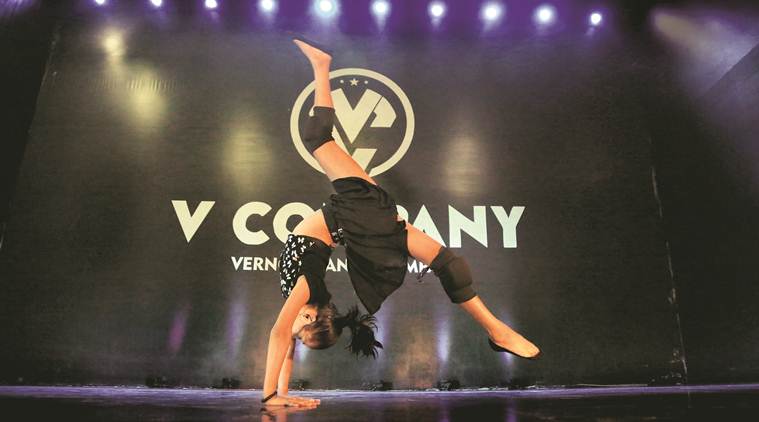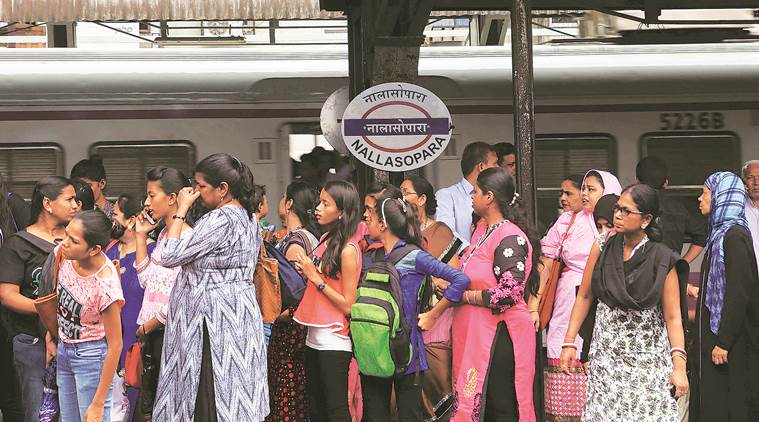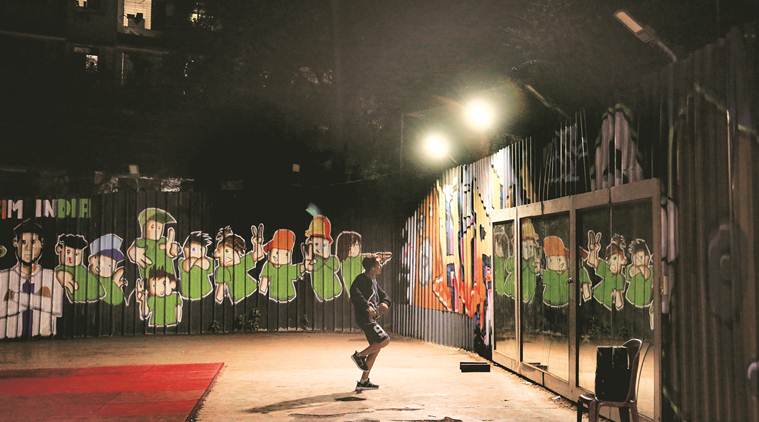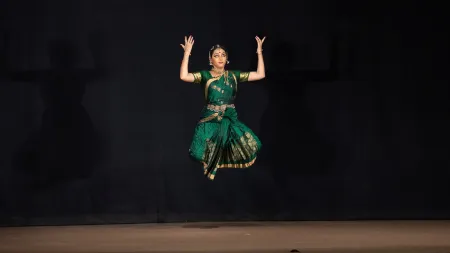- India
- International
Footloose in Nallasopara
Long, long ago, the lanes of Virar gave Bollywood its biggest dancing star in Govinda. Now from this region on Mumbai’s fringes are emerging TV dance show stars, YouTube hits, and film debuts. Next up, finds The Sunday Express, is 150 participants facing off in a ‘World Dance League’
 Bombay Lokal, a ‘hip-hop collective’, is set to feature in film Gully Boy, with Ranveer Singh, Alia Bhatt. (Express photo: Amit Chakravarty)
Bombay Lokal, a ‘hip-hop collective’, is set to feature in film Gully Boy, with Ranveer Singh, Alia Bhatt. (Express photo: Amit Chakravarty)
WRITING about the history of hip-hop on its website, the New York City Department of Parks and Recreation notes the role the city’s parks provided in establishing “the sound, fashion, art, and message of hip-hop”. Decades later and continents away, a town on the fringes of Mumbai, that also prides itself on its 140 gardens and parks, is set to host a self-styled ‘World Dance League’, a dance contest that is expected to draw over 150 participants, including from the Philippines, Nepal and New Zealand. Auditions for the Indian participants for the September 2019 contest have already begun, and were held in April in Bhusawal, Kolhapur, Solapur, Nagpur (all in Maharashtra) and Kolkata. Web auditions are open for participants across the world.
Nallasopara put itself on the hip-hop map after dancers from here bagged trophies across dance reality shows on Indian television channels, starting with Boogie Woogie in 2008, inspired the 2015 film Any Body Can Dance 2 that starred Prabhudeva, and competed on international platforms. Long, long ago, the Vasai-Virar belt in which Nallasopara falls also gave Bollywood one of its most successful dancing stars, Govinda.
Just like it flourished in the black ghettos of the Bronx and Compton in the US in the 1970s, hip-hop appears to have caught the fancy of the boys of Nallasopara — living and dreaming in the wide shadow cast by Mumbai’s glamour. They tell their stories through dance, in rap, via beat boxing and b-boying, and paint it out in graffiti.
Says ABCD 2 director and coveted Bollywood choreographer Remo D’Souza, “There is a lot of talent coming from humble backgrounds in the country, but I can say that the maximum such talent comes from Nallasopara… Many groups from Nallasopara have won dance shows and inspired others from there. You can see it in the open ground rehearsals, it’s in every gully, nukkad.”
About 20 km north of Mumbai’s last western suburb, the Vasai-Virar City Municipal Corporation, in charge of the 311-sq km area of Vasai, Nallasopara and Virar, is seen as a subaltern solution to Mumbai’s lack of affordable housing, and to migrants looking for a slice of the Mumbai dream.

The region has witnessed some development in the past years. Water problems have eased, and the Western Railway now runs 208 train services between Churchgate and Virar, a distance of 60 km. But, says Chairman of Anarock Property Consultants Anuj Puri, “it has an issue of perception”. “Though the connectivity to Mumbai has improved, people still feel it is far away,” he says.
 A participant performs at V-Company’s monthly dance competition in Vasai (Express photo: Amit Chakravarty)
A participant performs at V-Company’s monthly dance competition in Vasai (Express photo: Amit Chakravarty)
Plus, while Navi Mumbai has emerged as an IT hub, this fringe town can hardly lay claim to any economy, old or new. What it has are 140 public gardens and 50 lakes, through which Vasai-Virar lays claim to be a city “cleaner than Mumbai”. It’s to these very parks, hidden among the town’s apartment blocks and chawls, that many roads are headed.
On a Monday evening, young boys and girls, several with streaked locks and snazzy, asymmetrical hair cuts, have taken their seats on plastic chairs before a massive stage erected on the Vernon Dance Ground in the Gokhivare Talao area in Vasai (East). As the sun sets, Bruno Mars’s Uptown Funk fills the air and youth, earlier slouching in their seats, begin singing along and tapping their feet, stretching out their arms and shuffling their shoulders. Soon, everyone, barring the parents of some of the children, breaks into a dance, with handkerchiefs, bicycles and other props surfacing. Residents from neighbouring buildings stand at their windows to watch the participants perform.
The group of over 30 young people, all under 25, are either current or former students of Vernon Dance Company, commonly referred to as V-Company, and are doing a final rehearsal before the academy’s monthly dance competition, held on the 15,000 sq ft rented ground. The prize: a certificate from Vernon Monteiro, 27, who founded the dance studio in 2013. Monteiro is among the poster boys of Nallasopara’s hip-hop dancers, having won the first season of Dance +, one of the most popular dance shows on Star Plus with a 50-member V-Company crew (2014), as well as the third season of India’s Got Talent on Colors TV with partner Suresh Mukund (2013). In 2012, Monteiro and Mukund’s crew Fictitious competed at the World Hip-hop Championship in Las Vegas and finished among the eight finalists. It was this journey from Nallasopara to Las Vegas that inspired ABCD 2.
The Nallasopara-Vasai belt now has over 50 academies specialising in various dance forms, with hip-hop the most popular. But it’s Monteiro’s training studio that has become a pilgrimage spot of sorts for aspiring hip-hop dancers. Like Lakshita Dubey, 10, from Lucknow, rehearsing her ‘Krump’ moves — a dance form characterised by energetic, exaggerated hand and leg movements. Seated in one of the back rows, her mother Anu keeps reminding her to take sips of water in between.
 There is a lot of talent coming from humble backgrounds in the country, but I can say that the maximum such talent comes from Nallasopara: Remo D’Souza (Express photo: Amit Chakravarty)
There is a lot of talent coming from humble backgrounds in the country, but I can say that the maximum such talent comes from Nallasopara: Remo D’Souza (Express photo: Amit Chakravarty)
“Lakshita has been dancing since the age of three. People thought we were going overboard with our daughter’s dance dreams by moving here. But this is the best place for her to learn hip-hop,” says Anu, who has rented a flat for four months for Lakshita to train with V-Company. Her husband is a banker.
At the other end of the ground, barricaded with graffiti-painted asbestos sheet walls, Kishan Singh is practising before five full-sized mirrors. For the past couple of years, the 18-year-old, who hails from Ajmer in Rajasthan, has been trying his luck at dance reality shows. “Once I cleared the first elimination round but got thrown out in the next. After training at V-Company, I hope to make it to at least one show,” he says.
If not, Kishan adds, “I will probably go back and start my own dance academy to teach the boys in Ajmer.” He says he will have many willing learners.
Nineteen-year-old M C Sameer fled his home in Biratnagar, Nepal, reached Patna, and took a train to Borivali, before making it to Vasai in January. “I had to come here to learn hip-hop and I did,” he says impassively, while talking about his family’s opposition to his passion. To support himself he does odd jobs at a guest-house in Saki Naka. “I maintain the guest register, lock the doors at night, sleep there and eat the food they give me. I get Rs 8,000 a month. I spend the money on learning dance,” he says.
Tucking his blond bangs under a cap and continuing with his moves to the song Agar tum mil jao from the 2005 film Zeher, Sameer concedes, “I have improved, but I must do much better before I audition for a show.” Vijay Ganjawala, a grocery shop owner from Nallasopara East, has enrolled his 12-year-old daughter Khushi, who wants to become a choreographer, at V-Company. “Everyone wants to learn from them,” he says.
A little past 8 pm, Monteiro arrives. As he takes his place on a pedestal, what follows is a recreation of a television dance contest among the 30 contestants, complete with an anchor, audience, judge’s feedback and prizes. Kishore Kumar’s Hum the woh thi from the 1958 hit Chalti ka Naam Gaadi shows up among the hip-hop numbers.
Monteiro says students, who along with dance training need accommodation and food, pay Rs 50,000 for a four-month diploma course in hip-hop. The training includes syles like ‘Old School’, ‘Locking’, ‘Popping’, ‘House Dance’, ‘Krump’ and ‘New School’. Is there a Nallasopara style? “Flips and tricks,” says Monteiro. “That is our signature.”
Room No. 103/10, in a chawl behind Hanuman Mandir in Nallasopara East, is home to Bombay Lokal ‘hip-hop collective’. Their songs, written, composed and sung by them, have got them a fan following on YouTube channel. One song, All the way up (a Hindi remix), has over 36,000 views. Slices of daily life in Nallasopara are a recurring motif.
Next year, in what could be Bombay Lokal’s own crossover moment, members of the collective will be heard in Zoya Akhtar’s film Gully Boy, with Ranveer Singh and Alia Bhatt in the lead.
 The crew at their studio in a Nallasopara chawl (Express photo: Amit Chakravarty)
The crew at their studio in a Nallasopara chawl (Express photo: Amit Chakravarty)
Of the 13 members of Bombay Lokal, 11 live in Nallasopara. “The reason people here (in Nallasopara) push themselves to do their best is because they have to get out of here. It’s not just a hobby for anyone. It comes from growing up underprivileged,” says Gaurav Gambhir, beat-boxer at D-Cypher, who lives further north in Virar.
In the room, with its asbestos roof, is a plastic chair, a stool, old mattresses and a wall paper full of question mark symbols. A small, open cubicle next to the bathroom has been made sound-proof by sealing it with mattresses. The crew has pooled in to buy recording paraphernalia, that is plugged into a computer. It’s here that they record all their songs.
“We spent about Rs 25,000 to Rs 30,000 on the equipment,” says Akshay Poojary (20), a rapper, who goes by the name GRAVITY. The lead wordsmith of the crew, Aamir Shaikh (29), has adopted the stage name ‘Shaikhspeare’. His father, a civil engineer, moved to Nallasopara for work from Bhagalpur in Bihar. Shaikh, the eldest of four siblings, had just finished Class 10 then.
“When I first moved here from Bihar, everything felt different. I thought people would make fun of the way I speak, but they didn’t,” he says, adding, “There are a lot of migrant families here. It is a mix of different cultures, but no one is well off.”
Soon Shaikh, who graduated from ‘VIVA College’ in Virar, was visiting cyber cafes to listen to hip-hop and to download lyrics. Eminem, Tupac, and 50 Cent were among his early influences. Hesitantly showing the tattoo of American rapper Tupac on his arm, Shaikh says, “My mother hated my tattoos.”
 The ground surrounded by residential buildings which come alive every night to the sound, show of hip-hop (Express photo: Amit Chakravarty)
The ground surrounded by residential buildings which come alive every night to the sound, show of hip-hop (Express photo: Amit Chakravarty)
His songs are high on political commentary, he adds. “Being a liberal Muslim, I am often chided by members in my community and outside. Western music was always haraam for us. But I’ve never been very religious and had friends from all religions. But now ironically, sometimes I am also a target on social media because of my religion.”
On a Sunday afternoon, as the crew walk to their pad in their black T-shirts, bearing their stage names on the back, neighbours in their chawl look on indulgently. Minutes later, just as they are about to break into the staccato rhythms of their song Local train flow, on the locomotive that forms an inseparable part of their lives, there is a power cut.
Under the asbestos roof, the heat is unforgiving, and one of them quips, “A-C baahar hai (It’s A-C outside).” The small open space at the back at least offers some breeze.
Bombay Lokal’s beat-boxers don’t let the heat get to them and circle a pole as Praful Kamble (18) raps in Marathi. Kamble is the crew’s young apprentice. “Some day, I want to dance to my own song,” he says. “Sabki kala hai satrangi, meri kala hai atrangi (Everyone’s art is colourful, my art is unusual),” is a Hindi line in his Marathi song, that he concludes with “Ase amhi Nallasoparyache sharpshooter (This is how we are, the sharpshooters of Nallasopara).”
A commerce student at VIVA College, Kamble says he paid tribute to Dr B R Ambedkar through rap at an event in Nallasopara on the leader’s birth anniversary.
Shaikh, who gave up his content writer’s job at a private firm two months ago, says that it is only now, after 10 solo songs, two group songs, some tattoos and earrings, and a nose-piercing, that his family thinks he is set to arrive, with the film Gully Boy. The movie is expected to feature a rap battle between him and Ranveer Singh, he says.
“Bhule bhatke ko dikhate hum raasta taki naujawan na khaye durr-durr ki thokar, aate hum yahan choti jagah Sopara se hokar (We show the way so that youth don’t stumble, we come here via the tiny town of Sopara),” he raps.
Remo D’Souza and Vernon Monteiro are the main driving forces behind the World Dance League choosing Vasai for its first India contest. After some World Hip-Hip Championship participants were denied visas to travel to the US in 2016 and 2017, Monteiro says he and D’Souza decided to organise their own dance competition in India.
The performances of the participants at the contest will be recorded and then aired in a web series.
Kshitij Thakur, a two-time Nallasopara MLA, says they are looking forward to the contest. “Other than accommodation, whatever is required to host an event of that scale, is already there,” Thakur says. “We will talk to local developers of under-construction buildings that are on the verge of completion. We do that when we host an annual marathon here too. It all depends on the number of participants.”
The MLA also asserts that Nallasopara’s dance revolution is a byproduct of the Vasai Kreeda Kala Mahotsav started by his father, the Bahujan Vikas Aghadi (BVA) chief Hitendra Thakur, in 1990, and held in December every year. “The Mahotsav started with 3,500 participants but now sees up to 55,000. It is a huge platform for sports and arts in the region,” he says. The BVA controls the Vasai-Virar municipal corporation.
Welcoming the “new identity” of the Vasai-Virar region, as a residence of dancing stars, Deputy Mayor Prakash Rodrigues says the success of the home boys has not only inspired youth but also brought about a change in the mindset of parents. “Parents are no longer sending kids to just school and tuitions,” he adds.
 A dancer rehearsing for his turn (Express photo: Amit Chakravarty)
A dancer rehearsing for his turn (Express photo: Amit Chakravarty)
Apart from the Vasai Kreeda Kala Mahotsav, he believes the area’s Christian culture has also played a part in Nallasopara’s emergence as a dance hub. “Whenever we have a feast in our churches, we hold competitions such as dance or fancy-dress. It is through these competitions that talent is discovered,” Rodrigues says.
If not dance, what would draw people to Nallasopara? Says Thakur, “There are no mountains or rivers here. But we have some people coming for the Jeevdani and Vajreshwari temples, the old Portuguese churches and Buddhist stupas. There is a sea shore, but it has brown, water-soluble sand.”
Ajay Pardeshi says that for people like him, Nallasopara’s beauty lies elsewhere, as embodied by the Bhojpuri singer in the 2014 number that changed his fortunes. ‘Hay re hay Nallasopara’, Pardeshi sang, “Bees deposit, du hajaar bhada, hota gareebon ka hai gujara. Hay re hay re Nallasopara, hum ko lagta hai bada pyaara (Rs 20,000 deposit, two thousand rent, opening arms to the poor. Oh Nallasopara, that is why to us you are so dear)”.
Pardeshi came to Nallasopara 10 years ago, from hometown Jaunpur in Uttar Pradesh. Now the father of three earns between Rs 15,000 and Rs 25,000 per performance, and has his own music label.
Apr 19: Latest News
- 01
- 02
- 03
- 04
- 05


































